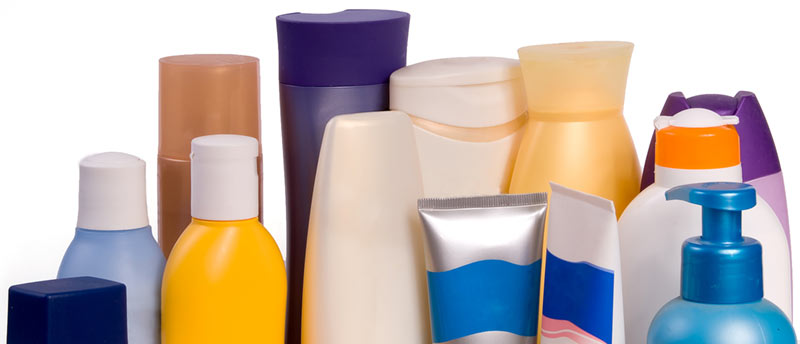7 Dangerous Ingredients in Everyday Cosmetics and Toiletries

Today, "all-natural" cosmetics and toiletry products line store shelves. But, are these natural products better for consumers? Is everything labeled "all-natural" free of unhealthy or unsafe ingredients?
The key is to be your own investigator. Read those labels. Consult reputable sources to confirm ingredient safety.
To help, we have compiled a list of seven common unsafe ingredients found in personal care products. These ingredients have been linked to real health concerns.
1. Parabens
Commonly Found In: Makeup, shampoo, moisturizer, shaving creams
A paraben is an ingredient used to extend a product's shelf life. Propylparaben and ethylparaben are two examples of parabens found in personal care products.
Some parabens, such as potassium or calcium paraben, pose a low risk to users. Others, such as butylparaben and isopropylparaben, may be very hazardous.
The main concern lies in parabens disrupting the endocrine system of the body. This can potentially lead to breast cancer or early puberty.
2. Talcum Powder
Commonly Found In: Baby powder and other powders
Talcum powder - more commonly known as baby powder - has received much media attention in recent years. This is due to its tie with several high-profile lawsuits.
There are three ways that talcum powder is harmful.
- Lung damage -- Even though it's called baby powder, health and safety experts have urged people not to use talcum powder on babies. It can irreparably harm the lungs if inhaled.
- Asbestos exposure -- Talc is a naturally occurring mineral used to make talcum powder. The mineral is often found in deposits near asbestos. Asbestos is a known carcinogen. Because of the proximity between these two minerals, traces of asbestos have been found in talc products.
- Ovarian cancer -- Talcum powder has been tied to the development of ovarian cancer. This tie is linked to women who use talcum powder in their pelvic area.
3. Phthalates
Commonly Found In: Nail polish, perfume, shampoo
Phthalates describes a certain set of chemicals often used to make plastic sturdier. It is sometimes used for dissolving. The U.S. Food and Drug Administration (FDA) does not have a firm position on phthalates.
However, studies have shown a link between phthalates and several health conditions including:
- Decreased hormone levels
- Endometriosis
- Low sperm quality
- Obesity
- Resistance to insulin
- Ovarian aging
- Cancer
4. Formaldehyde
Commonly Found In: Eyelash glue, perfume, hair products, nail polish
Formaldehyde and formaldehyde-releasing preservatives are sometimes used in cosmetic and toiletry products. These ingredients are used to increase the shelf life of products.
The National Toxicity Program labels Formaldehyde as "known to be a human carcinogen." The Environmental Working Group (EWG) has labeled it a 10, which is the highest number on their hazard rating system.
5. Lead
Commonly Found In: Lipstick
The Campaign for Safe Cosmetics found that 61% of lipsticks contain some level of lead. The FDA explored this claim. The agency found lead content in 400 lipsticks. Many of these lipsticks were from L'Oreal USA.
According to Mayo Clinic, lead poisoning can lead to many unwanted side effects in adults such as:
- High blood pressure
- Joint pain
- Muscle pain
- Abdominal pain
- Difficulties with memory or concentration
- Headaches
- Mood disorders
- Reduced sperm count
- Abnormal sperm
Lead can also cause severe complications for pregnant women such as miscarriages or premature birth.
6. Diethanolamine (DEA)
Commonly Found In: Shampoo, soap, shaving cream
Diethanolamine (DEA) is often used as an emulsifier or foaming agent in toiletry products. It creates the sudsy quality in some products. The European Commission banned DEA in cosmetics. It is still allowed in the United States.
However, a 1998 study by the National Toxicology Program found a correlation between DEA and cancer in lab animals. Because there has not been human testing, DEA is still approved by the FDA.
The California Department of Public Health, however, listed codamide DEA with possible cancer toxicity.
7. Retinyl Palmitate
Commonly Found In: Sunscreen, lipstick, moisturizer, face makeup
Retinyl palmitate is often found in sunscreens. However, it has been shown to increase development of skin tumors when exposed to sunlight. Retinyl palmitate is also known as vitamin A palmitate. It is commonly found in cosmetic products such as a skin conditioner.
Yet, in a study by the National Toxicology Program, the use of Retinyl palmitate creme enhanced the photocarcinogenicity activity of mice.
The EWG also lists other negative health concerns linked to retinyl palmitate including reproductive toxicity.
What To Do About These Troubling Ingredients
Now that you have this information, take a peek in your medicine cabinet. Look under your sink. Comb through your make-up bag. Check to see if any of these unhealthy chemicals have been hiding in your favorite products.
To shift away from using these ingredients without breaking the bank, replace each item as it runs out with a chemical-free option. In a few months, you should have a cosmetic and toiletry collection you can feel safe using. You can even ask for some safer replacements as holiday gifts. Then, you can go into the new year with a healthier set of products.
But, never take "all natural" marketing at its word. Even natural ingredients - like talc and lead - can be extremely harmful. Research is necessary to make informed consumer decisions.
